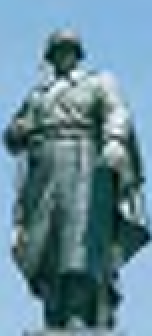Travel Reference
In-Depth Information
Peter Joseph Lenné
Lenné (1789-1866), regarded as
Germany's most important land-
scape architect, was born into a
family of gardeners in Bonn. He
studied in Paris and joined the
Royal Gardens in Potsdam as an
apprentice in 1816. There he met
Schinkel and, together, these two
men set out to design the parks
of Berlin and Potsdam in the
harmonious style of the time.
Main entrance Bendlerblock
Hamburger Bahnhof
The former Hamburg railway
station, now the “Museum of
the Present Day , holds a cross-
section of contemporary paint-
ings and the latest multi-media
works of art and installations.
One of the highlights is the
private collection of Erich Marx,
including works by Beuys and
others. Apart from well-known
artists such as Andy Warhol,
Jeff Koons and Robert
Rauschenberg, it also shows
works by Anselm Kiefer and
Sandro Chiao
.
d
Invalidenstr.
50-51
•
Map F2
•
10am-6pm
Tue-Fri, 11am-6pm Sat, Sun
•
Admission charge
Sergijevski, is crowned by the
huge bronze statue by Lev Ker-
bel. Behind the memorial, 2,500
Russian soldiers are buried.
d
Straße des 17. Juni
•
Map K2
Gedenkstätte
Deutscher Widerstand
The 1930s complex, which is
today known as Bendlerblock,
lies behind the former Prussian
Ministry of War. During World
War II it served as army head-
quarters. It was here that a
group of officers planned
the assassination of Adolf
Hitler. When the attempt
failed on 20 July 1944,
Claus Schenk Count von
Stauffenberg and the
others involved were
arrested in the Bendler-
block, and many of them
were shot in the courtyard
during the night. A
memorial, created by
Richard Scheibe in
1953, commemorates these
events. On the upper floor is a
small exhibition documenting the
German resistance against the
Nazi regime. Today, the Bendler-
block has been incorporated into
the Berlin branch of the Federal
Ministry of Defence.
d
Stauffen-
bergstr. 13-14
•
Map E4
•
9am-6pm
Mon-Wed, Fri, 9am-8pm Thu, 10am-6pm
Sat, Sun
•
(030) 26 99 50 00
•
Admission charge
Sowjetisches
Ehrenmal
The giant Soviet Memorial
near Brandenburg Gate was
officially opened on
7 November 1945, the
anniversary of the Russ-
ian October Revolution. It is
flanked by two tanks, supposed-
ly the first ones to reach Berlin.
The memorial commemorates
300,000 Red Army soldiers who
died during World War II in the
struggle to liberate Berlin. The
large column was constructed
from marble blocks from Hitler's
Reich Chancellery, which had
just been torn down. The column
itself, designed by Nicolai
Sowjetisches Ehrenmal
98










